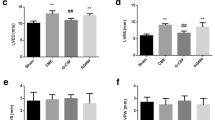Abstract
Purpose
Recent studies suggest that G-CSF prevents cardiac remodeling following myocardial infarction (MI) likely through regeneration of the myocardium and coronary vessels. However, it remains unclear whether G-CSF administered at the onset of reperfusion prevents ischemia/reperfusion injury in the acute phase. We investigated acute effects of G-CSF on myocardial infarct size and the incidence of lethal arrhythmia and evaluated the involvement of the phosphatidylinositol-3 kinase (PI3K) in the in vivo canine models.
Methods
In open-chest dogs, left anterior descending coronary artery (LAD) was occluded for 90 minutes followed by 6 hours of reperfusion. We intravenously administered G-CSF (0.33 μ/kg/min) for 30 minutes from the onset of reperfusion. Wortmannin, a PI3K inhibitor, was selectively administered into the LAD after the onset of reperfusion.
Results
G-CSF significantly (p<0.05) reduced myocardial infarct size (38.7±4.3% to 15.7±5.3%) and the incidence of ventricular fibrillation during reperfusion periods (50% to 0%) compared with the control. G-CSF enhanced Akt phospholylation in ischemic canine myocardium. Wortmannin blunted both the infarct size-limiting and anti-arrhythmic effects of G-CSF. G-CSF did not change myeloperoxidase activity, a marker of neutrophil accumulation, in the infarcted myocardium.
Conclusion
An intravenous administration of G-CSF at the onset of reperfusion attenuates ischemia/reperfusion injury through PI3K/Akt pathway in the in vivo model. G-CSF administration can be a promising candidate for the adjunctive therapy for patients with acute myocardial infarction.
Similar content being viewed by others
Abbreviations
- VF:
-
ventricular fibrillation
- G-CSF:
-
granulocyte colony-stimulating factor
- WTMN:
-
wortmannin
References
Clark SC, Kamen R. The human hematopoietic colonystimulating factors. Science 1987;236:1229–37.
To LB, Haylock DN, Simmons PJ, Juttner CA. The biology and clinical uses of blood stem cells. Blood 1997;89:2233–58.
Kronenwett R, Martin S, Haas R. The role of cytokines and adhesion molecules for mobilization of peripheral blood stem cells. Stem Cells 2000;18:320–30.
Orlic D, Kajstura J, Chimenti S, et al. Mobilized bone marrow cells repair the infarcted heart, improving function and survival. Proc Natl Acad Sci USA 2001;98:10344–9.
Ohtsuka M, Takano H, Zou Y, et al. Cytokine therapy prevents left ventricular remodeling and dysfunction after myocardial infarction through neovascularization. Faseb J 2004;18:851–3.
Harada M, Qin Y, Takano H, et al. G-CSF prevents cardiac remodeling after myocardial infarction by activating the Jak-Stat pathway in cardiomyocytes. Nat Med 2005;11:305–11.
Nicod P, Gilpin E, Dittrich H, et al. Late clinical outcome in patients with early ventricular fibrillation after myocardial infarction. J Am Coll Cardiol 1988;11:464–70.
Rouleau JL, Talajic M, Sussex B, et al. Myocardial infarction patients in the 1990s—their risk factors, stratification and survival in Canada: the Canadian Assessment of Myocardial Infarction (CAMI) Study. J Am Coll Cardiol 1996;27:1119–27.
Lothrop CD Jr, Warren DJ, Souza LM, Jones JB, Moore MA. Correction of canine cyclic hematopoiesis with recombinant human granulocyte colony-stimulating factor. Blood 1988;72:1324–8.
Hirata A, Minamino T, Asanuma H, et al. Erythropoietin just before reperfusion reduces both lethal arrhythmias and infarct size via the phosphatidylinositol-3 kinase-dependent pathway in canine hearts. Cardiovasc Drugs Ther 2005;19:33–40.
Maruyama R, Takemura G, Aoyama T, et al. Dynamic process of apoptosis in adult rat cardiomyocytes analyzed using 48-hour videomicroscopy and electron microscopy: beating and rate are associated with the apoptotic process. Am J Pathol 2001;159:683–91.
Asanuma H, Kitakaze M, Funaya H, et al. Nifedipine limits infarct size via NO-dependent mechanisms in dogs. Basic Res Cardiol 2001;96:497–505.
Holm S. A simple sequentially rejective multiple test procedure. Scand J Statist 1979;6:65–70.
Hale SL, Lange R, Alker KJ, Kloner RA. Correlates of reperfusion ventricular fibrillation in dogs. Am J Cardiol 1984;53:1397–400.
Bolli R, Patel B. Factors that determine the occurrence of reperfusion arrhythmias. Am Heart J 1988;115:20–9.
Iwanaga K, Takano H, Ohtsuka M, et al. Effects of G-CSF on cardiac remodeling after acute myocardial infarction in swine. Biochem Biophys Res Commun 2004;325:1353–9.
Gabrilove JL, Jakubowski A, Fain K, et al. Phase I study of granulocyte colony-stimulating factor in patients with transitional cell carcinoma of the urothelium. J Clin Invest 1988;82:1454–61.
Bensinger WI, Clift RA, Anasetti C, et al. Transplantation of allogeneic peripheral blood stem cells mobilized by recombinant human granulocyte colony stimulating factor. Stem Cells 1996;14:90–105.
Ince H, Petzsch M, Kleine HD, et al. Prevention of left ventricular remodeling with granulocyte colony-stimulating factor after acute myocardial infarction: final 1-year results of the Front-Integrated Revascularization and Stem Cell Liberation in Evolving Acute Myocardial Infarction by Granulocyte Colony-Stimulating Factor (FIRSTLINEAMI) Trial. Circulation 2005;112:I73–80.
Ince H, Petzsch M, Kleine HD, et al. Preservation from left ventricular remodeling by front-integrated revascularization and stem cell liberation in evolving acute myocardial infarction by use of granulocyte-colony-stimulating factor (FIRSTLINE-AMI). Circulation 2005;112:3097–106.
Avalos BR. Molecular analysis of the granulocyte colonystimulating factor receptor. Blood 1996;88:761–77.
Tsang A, Hausenloy DJ, Mocanu MM, Yellon DM. Postconditioning: a form of “modified reperfusion” protects the myocardium by activating the phosphatidylinositol 3-kinase-Akt pathway. Circ Res 2004;95:230–2.
Kang HJ, Kim HS, Zhang SY, et al. Effects of intracoronary infusion of peripheral blood stem-cells mobilised with granulocyte-colony stimulating factor on left ventricular systolic function and restenosis after coronary stenting in myocardial infarction: the MAGIC cell randomised clinical trial. Lancet 2004;363:751–6.
Weisbart RH, Golde DW, Clark SC, Wong GG, Gasson JC. Human granulocyte-macrophage colony-stimulating factor is a neutrophil activator. Nature 1985;314:361–3.
Barron HV, Cannon CP, Murphy SA, Braunwald E, Gibson CM. Association between white blood cell count, epicardial blood flow, myocardial perfusion, and clinical outcomes in the setting of acute myocardial infarction: a thrombolysis in myocardial infarction 10 substudy. Circulation 2000;102: 2329–34.
Adachi Y, Imagawa J, Suzuki Y, et al. G-CSF treatment increases side population cell infiltration after myocardial infarction in mice. J Mol Cell Cardiol 2004;36:707–10.
Sugano Y, Anzai T, Yoshikawa T, et al. Granulocyte colonystimulating factor attenuates early ventricular expansion after experimental myocardial infarction. Cardiovasc Res 2005;65:446–56.
Author information
Authors and Affiliations
Corresponding author
Additional information
Takahama and Hirata contributed equally to this work.
Rights and permissions
About this article
Cite this article
Takahama, H., Minamino, T., Hirata, A. et al. Granulocyte Colony-Stimulating Factor Mediates Cardioprotection Against Ischemia/Reperfusion Injury via Phosphatidylinositol-3-Kinase/Akt Pathway in Canine Hearts. Cardiovasc Drugs Ther 20, 159–165 (2006). https://doi.org/10.1007/s10557-006-8285-8
Published:
Issue Date:
DOI: https://doi.org/10.1007/s10557-006-8285-8




